合肥工业大学计组实验四
Posted 上衫_
tags:
篇首语:本文由小常识网(cha138.com)小编为大家整理,主要介绍了合肥工业大学计组实验四相关的知识,希望对你有一定的参考价值。
实验目的
通过设计并实现支持一条指令的CPU,理解和掌握CPU设计的基本原理和过程。
实验内容
设计和实现一个支持加法指令的单周期CPU。要求该加法指令(表示为add r1,r2,r3)格式约定如下:
采用寄存器寻址,r1,r2,r3为寄存器编号,r1和r2存放两个源操作数,r3为目标寄存器,其功能为[r1] + [r2] -> r3;
指令字长16位,操作码和地址码字段分配如下所示:

实验原理
1. 各个部件的功能及端口
- PC
在每个时钟周期上沿对pc加一后输出,从而得到下一条要执行的指令。
端口:clk、rst、[7:0]pc

- ROM
输出要执行的指令。
端口:[7:0]pc、[15:0]ins
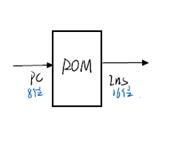
- CU
分析从ROM中取出的指令,从而控制ALU和寄存器堆RF的动作。
端口:[6:0]opcode、wr_en、[2:0]alu_op
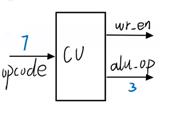
- ALU
根据指令的不同,完成不同的运算。
端口:[15:0]in1、[15:0]in2、[2:0]alu_op、[15:0]z

- RF
通用寄存器堆
端口:[2:0]read_reg1、[2:0]read_reg2、[2:0]write_reg、[15:0]write_data、clk、wr_en、[15:0]reg1、[15:0]reg2
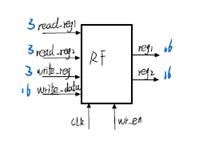
2. 数据通路连接
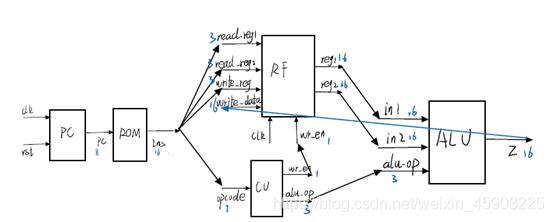
实验过程
1. 各个部件的设计
PC
1. module PC(
2. input clk,
3. input rst,
4. output reg [7:0] pc
5. );
6. initial pc=8'd0;
7. always@(posedge clk) begin
8. begin
9. if(rst==1)
10. pc<=8'd0;
11. else
12. pc<=pc+1'd1;
13. end
14. end
15. endmodule
ROM
1. module ROM(
2. input wire [7:0] pc,
3. output reg [15:0] ins
4. );
5.
6. reg [15:0] ROM_data [255:0];
7. integer i;
8.
9. initial $readmemb("D:/vivadowork/ONE_CPU/ONE_CPU.srcs/sources_1/new/ROM_initial.txt",ROM_data);
10.
11. always@(pc) begin
12. ins<=ROM_data[pc];
13. end
14. endmodule
CU
由于目前只需要实现一条指令,所以CU的设计比较简单,等后面设计多指令时再继续完善。
1. module CU(
2. input wire [6:0] opcode,
3. output reg wr_en,
4. output reg [2:0] alu_op
5. );
6. always@(opcode)begin
7. wr_en<=1'd1;
8. alu_op<=3'd1;
9. end
10.
11. endmodule
ALU
1. module ALU(
2. input wire[15:0] in1,
3. input wire[15:0] in2,
4. input wire[2:0] alu_op,
5. output reg[15:0] z
6. );
7. always @(*)
8. begin
9. case(alu_op)
10. 3'b001: z<=in1+in2;
11. 3'b010: z<=in1-in2;
12. 3'b011: z<=in1&in2;
13. 3'b100: z<=in1|in2;
14. 3'b101: z<=in1<<in2;
15. 3'b110: z<=in1>>in2;
16. endcase
17. end
18. endmodule
RF
1. module RF(
2. input wire [2:0] read_reg1,
3. input wire [2:0] read_reg2,
4. input wire [15:0] write_data,
5. input wire [2:0] write_reg,
6. input wire wr_en,
7. input wire clk,
8. input wire rst,
9. output wire [15:0] reg1,
10. output wire [15:0] reg2
11. );
12. reg [15:0] rf [7:0];
13.
14. initial $readmemh ("D:/vivadowork/ONE_CPU/ONE_CPU.srcs/sources_1/new/RF_initial.txt",rf);
15.
16. integer i;
17.
18. always @(posedge clk )
19. begin
20. begin
21. if(wr_en==1)
22. rf[write_reg]<=write_data;
23. end
24. end
25. assign reg1=rf[read_reg1];
26. assign reg2=rf[read_reg2];
27. endmodule
2. 顶层文件封装实现
1. module CPU(
2. input clk,
3. input rst,
4. output wire [7:0] pc,
5. output wire [15:0] ins,
6. output wire [2:0] alu_op,
7. output wr_en,
8. output wire [15:0] z,
9. output wire [15:0] reg1,
10. output wire [15:0] reg2
11. );
12.
13.
14. PC f_pc(
15. .clk(clk),
16. .rst(rst),
17. .pc(pc));
18.
19. ROM f_rom(
20. .pc(pc),
21. .ins(ins));
22.
23. CU f_cu(
24. .opcode(ins[15:9]),
25. .wr_en(wr_en),
26. .alu_op(alu_op)
27. );
28.
29. RF f_rf(
30. .read_reg1(ins[8:6]),
31. .read_reg2(ins[5:3]),
32. .write_reg(ins[2:0]),
33. .write_data(z),
34. .clk(clk),
35. .wr_en(wr_en),
36. .reg1(reg1),
37. .reg2(reg2)
38. );
39.
40. ALU f_alu(
41. .in1(reg1),
42. .in2(reg2),
43. .alu_op(alu_op),
44. .z(z)
45. );
46. endmodule
3. CPU模拟仿真
1) 仿真说明
ROM初始化内容:
将以下两条命令重复128次。
0000001001010011
0000001100011010
命令解释:此次实验我将加法指令的设为0000001,后面指令的意思是将001b号寄存的内容与010b号寄存器的内容相加再将结果保存到011b号寄存器中;下一条指令同理,将100b号寄存器的内容与011b号寄存器的内容相加再将结果保存到010b号寄存器中。
RF初始化内容:
0001
0002
000A
0011
0015
0756
100F
0000
RF内容是以十六进制数据初始化的。
2) 仿真代码设计
每20ns为一个时钟周期,总共运行20个周期。
1. module test_CPU;
2. reg clk;
3. reg rst;
4. wire [7:0] pc;
5. wire [15:0] ins;
6. wire wr_en;
7. wire [2:0] alu_op;
8. wire [15:0] reg1;
9. wire [15:0] reg2;
10. wire [15:0] z;
11.
12. initial begin
13. clk=1'd0;
14. forever #10 clk=~clk;
15. end
16.
17. initial begin
18. rst=1'd0;
19. #400 $stop;
20. end
21.
22. CPU test(
23. .clk(clk),
24. .rst(rst),
25. .z(z),
26. .pc(pc),
27. .ins(ins),
28. .wr_en(wr_en),
29. .alu_op(alu_op),
30. .reg1(reg1),
31. .reg2(reg2)
32. );
33. endmodule
3) 仿真结果
reg1 + reg2 = z
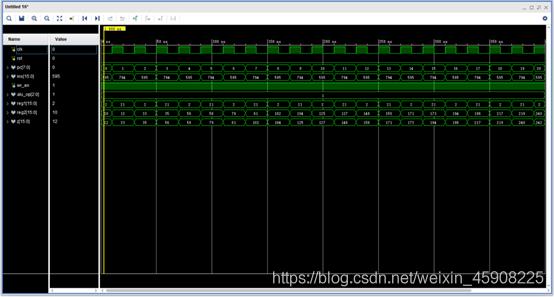
进一步实验
(一) 增加st指令
1. 分析
st指令

需要添加的部件:RAM
端口:[15:0]in_data、[5:0]index、clk、m_wr_en、[15:0]out_data
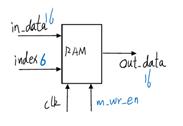
1. module RAM(
2. input clk,
3. input m_wr_en,
4. input wire [15:0] in_data,
5. input wire [5:0] index,
6. output wire [15:0] out_data
7. );
8.
9. reg [15:0] initdata [1023:0];
10. integer i;
11. initial $readmemb("D:/vivadowork/ONE_CPU/ONE_CPU.srcs/sources_1/new/RAM_initial",initdata);
12. // initial begin
13. // for( i=0;i<1024;i=i+1)
14. // initdata[i]<=16'b0;
15. // end
16.
17. always@(posedge clk ) begin
18. begin if (m_wr_en==0)
19. initdata[index]<=in_data;
20. end
21. end
22.
23. assign out_data=initdata[index];
24. endmodule
2. 更改顶层文件
数据通路更新

顶层文件更新
1. module CPU(
2. input clk,
3. input rst,
4. output wire [7:0] pc,
5. output wire [15:0] ins,
6. output wire [2:0] alu_op,
7. output wr_en,
8. output m_wr_en,
9. output wire [15:0] z,
10. output wire [15:0] reg1,
11. output wire [15:0] reg2,
12. output wire [15:0] out_data
13. );
14.
15.
16. PC f_pc(
17. .clk(clk),
18. .rst(rst),
19. .pc(pc));
20.
21. ROM f_rom(
22. .pc(pc),
23. .ins(ins));
24.
25. RAM f_ram(
26. .clk(clk),
27. .m_wr_en(m_wr_en),
28. .in_data(reg1),
29. .index(ins[5:0]),
30. .out_data(out_data)
31. );
32.
33. CU f_cu(
34. .opcode(ins[15:9]),
35. .wr_en(wr_en),
36. .alu_op(alu_op),
37. .m_wr_en(m_wr_en) //
38. );
39.
40. RF f_rf(
41. .read_reg1(ins[8:6]),
42. .read_reg2(ins[5:3]),
43. .write_reg(ins[2:0]),
44. .write_data(z),
45. .clk(clk),
46. .wr_en(wr_en),
47. .reg1(reg1),
48. .reg2(reg2)
49. );
50.
51. ALU f_alu(
52. .in1(reg1),
53. .in2(reg2),
54. .alu_op(alu_op),
55. .z(z)
56. );
57. endmodule
3. 模拟仿真
1) 仿真说明
RAM大小为1024
2) ROM初始化
0000010001000001 //0000010 表示为存数指令 001 表示要读取的寄存器 000001 表示要保存的RAM的地址
0000001011000001 //0000001 表示为加法命令
3) RAM初始化,将以下两条重复512次。
1010001111010100
0000110101110011
4) 仿真结果
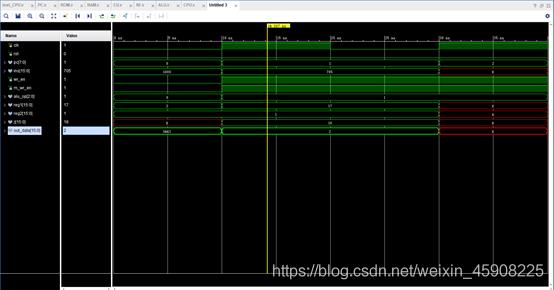
(二) 增加 加法 add、立即数加 addi、存数 st、取数 ld
1. 分析指令

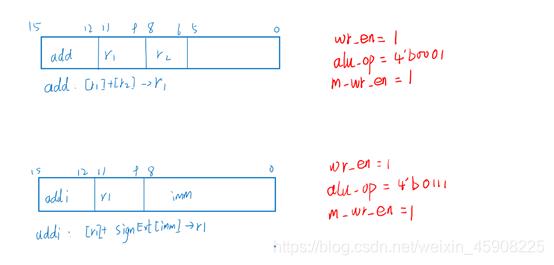
分析指令可知需要将更改控制器CU和运算器ALU的代码,现做更改如下:
CU:使用case语句分别对应四种指令,每种情况输出不同的wr_en alu_op m_wr_en以实现对应的功能。
ALU:之前ALU中的alu_op位数为3,现在增加了两种操作addi与ld,所以将alu_op位数改为4,同时增加两种运算:
①扩展立即数并与in1相加
②将从RAM中读出的out_data赋值给z,以便于将其写入RF。
1. module CU(
2. input wire [3:0] opcode,
3. output reg wr_en,
4. output reg m_wr_en,
5. output reg [2:0] alu_op
6. );
7. always@(opcode)begin
8. case(opcode)
9. 4'b0001: begin //add
10. wr_en<=1'd1;
11. alu_op<=3'b001;
12. m_wr_en<=1'd1;
13. end
14. 4'b0010: begin //addi
15. wr_en<=1'd1;
16. alu_op<=3'b111;
17. m_wr_en<=1'd1;
18. end
19. 4'b0011: begin //st
20. wr_en<=1'd0;
21. alu_op<=3'd0;
22. m_wr_en<=1'd0;
23. end
24. 4'b0100: begin //lod
25. wr_en=1'b1;
26. alu_op<=3'd0;
27. m_wr_en<=1'd1;
28. end
29. endcase
30. end
31. endmodule
进一步更改alu文件,由于addi指令需要进行符号为扩展,所以在ALU中增加相应的功能;ld指令要将RAM中读取到的数据保存到RF中,
1. module ALU(
2. input wire[15:0] in1,
3. input wire[15:0] in2,
4. input wire[8:0] imm,
5. input wire[3:0] alu_op,
6. input wire[15:0] out_data,
7. output reg[15:0] z
8. );
9. always @(*)
10. begin
11. case(alu_op)
12. 4'b0001: z<=in1+in2;
13. 4'b0010: z<=in1-in2;
14. 4'b0011: z<=in1&in2;
15. 4'b0100: z<=in1|in2;
16. 4'b0101: z<=in1<<in2;
17. 4'b0110: z<=in1>>in2;
18. 4'b0111: z<=6imm[8],imm+in1;
19. 4'b1000: z<=out_data;
20. endcase
21. end
22. endmodule
最后修改顶层文件,增加alu的输入内容。
1. module CPU(
2. input clk,
3. input rst,
4. output wire [7:0] pc,
5. output wire [15:0] ins,
6. output wire [3:0] alu_op,
7. output wr_en,
8. output m_wr_en,
9. output wire [15:0] z,
10. output wire [15:0] reg1,
11. output wire [15:0] reg2,
12. output wire [15:0] out_data
13. );
14.
15.
16. PC f_pc(
17. .clk(clk),
18. .rst(rst),
19. .pc